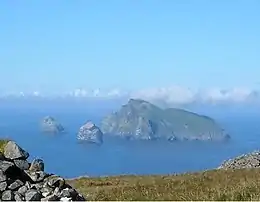East Burra
East Burra (Scots: East Burra; Old Norse: "Barrey"[7]) is one of the Scalloway Islands, a subgroup of the Shetland Islands in Scotland. It is connected by a bridge to West Burra.
| Scots name | East Burra[1] |
|---|---|
| Old Norse name | Barrey[2] |
| Meaning of name | east broch island? |
| Location | |
 East Burra East Burra shown within Shetland | |
| OS grid reference | HU388339 |
| Coordinates | 60.08°N 1.31°W |
| Physical geography | |
| Island group | Shetland |
| Area | 515 ha |
| Area rank | 73 [3] |
| Highest elevation | 81 m |
| Administration | |
| Sovereign state | United Kingdom |
| Country | Scotland |
| Council area | Shetland Islands |
| Demographics | |
| Population | 76[4] |
| Population rank | 49 [3] |
| Population density | 15 people/km2[4][5] |
| References | [5][6] |

With an area of 515 hectares (1,273 acres) it is the twelfth largest of the Shetland Islands.
East Burra has a much smaller population than West Burra and no substantial settlement; rather, there are a few hamlets and a scattering of individual croft houses. It is known for its Neolithic remains including a burnt mound, and for sea caves. The roofless, plain, Old Haa (manor or laird's house) of Houss is a prominent feature. From Houss, it is possible to walk the two kilometres or so to the cliffs at the southern end of the island. From there, the island of South Havra, nowadays home only to sheep and seabirds, can be clearly seen.
East Burra is linked to the Shetland Mainland via West Burra and Trondra by a series of bridges.
Etymology
Collins Encyclopedia of Scotland suggests that the name "Burra" is a corruption of "Borgarey" (island of the broch),[8] and while this is unlikely, and no broch is extant, the place name Brough, on West Burra lends some support to this case. However, the form used in the Orkneyinga saga is "Barrey".[2]
References
- "Map of Scotland in Scots - Guide and gazetteer" (PDF).
- Anderson, Joseph (ed.) (1873) The Orkneyinga Saga. Translated by Jón A. Hjaltalin & Gilbert Goudie. Edinburgh. Edmonston and Douglas. The Internet Archive. Retrieved 26 August 2013.
- Area and population ranks: there are c. 300 islands over 20 ha in extent and 93 permanently inhabited islands were listed in the 2011 census.
- National Records of Scotland (15 August 2013). "Appendix 2: Population and households on Scotland's Inhabited Islands" (PDF). Statistical Bulletin: 2011 Census: First Results on Population and Household Estimates for Scotland Release 1C (Part Two) (PDF) (Report). SG/2013/126. Retrieved 14 August 2020.
- Haswell-Smith, Hamish (2004). The Scottish Islands. Edinburgh: Canongate. ISBN 1-84195-454-3.
- Ordnance Survey. OS Maps Online (Map). 1:25,000. Leisure.
- Anderson, Joseph (Ed.) (1893) Orkneyinga Saga. Translated by Jón A. Hjaltalin & Gilbert Goudie. Edinburgh. James Thin and Mercat Press (1990 reprint). ISBN 0-901824-25-9
- Keay, J. & Keay, J. (1994) Collins Encyclopaedia of Scotland. London. HarperCollins.

